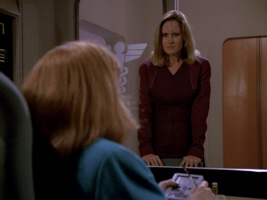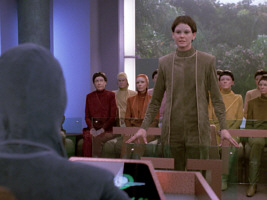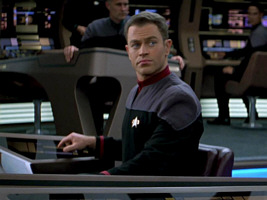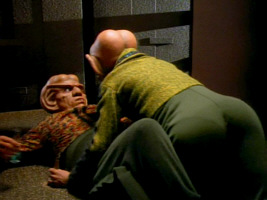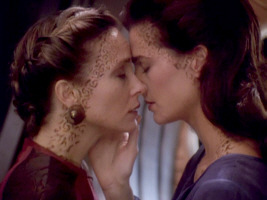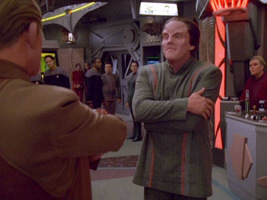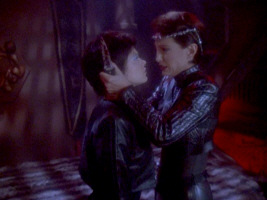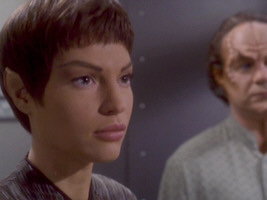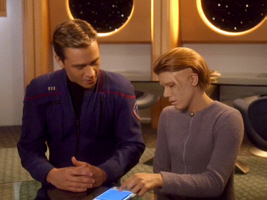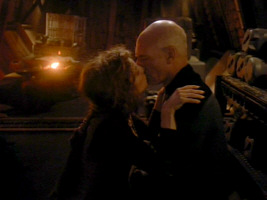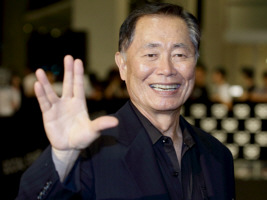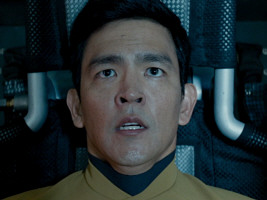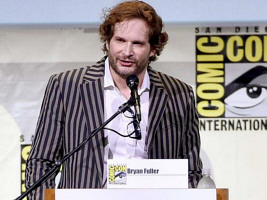Homosexuality in Star Trek
 Homosexuality has a firm place in official Star Trek now, so this topic can be closed.
Homosexuality has a firm place in official Star Trek now, so this topic can be closed.Yet, there is one last field (at least, one field of high social relevance) in which Star Trek did not accomplish the goal of equality for a long time. Except for a few occasional innuendos, homosexuality was absent from the Star Trek Universe. Everyone of the characters seemed to be straight by default. And while other mainstream TV series did include same-sex relationships in some fashion since around the year 2000, the gay, lesbian and bisexual Star Trek fans were waiting to be acknowledged in their favorite fictional universe. Since the early days of TNG their hopes were nourished by occasional testimonies from the producers or actors who kept promising that one day there would be outspoken homosexuality in the show, as well as by rumors whenever a new character was to appear who could be gay. Several groups were committed to promoting lesbian, gay or bisexual appearances on Star Trek.
Motivation
The motivation to get homosexuality into canon Star Trek should be distinguished from another phenomenon, the so-called slash fiction. "Slash" because it all started with the "Kirk/Spock" stories whose authors took it for granted that there was a sexual liaison between the two. While the idea to work towards sexual diversity is generally the same, the slash authors take it one step further and often too far. They have written erotic slash stories about virtually every combination of regular characters of equal sex. Getting gay or lesbian characters onto the screen is about adjusting the statistics and doing justice to a group of fans who have been ignored so far. Slash fiction (which is often not even written by fans who are homosexual themselves), on the other hand, is chiefly a matter of taste. Probably more than usual fan fiction that is well within the bounds of canon Trek. Ultimately the lacking acceptance of slash fiction lies in the nature of the stories that are purposely written to appeal only to a minority of fans, rather than in homophobia of those who just don't like it.
I refrain from commenting on "evidence" from the series that may justify slash fiction. There are subtle gestures that purportedly imply that a character is attracted to another one of the same sex and that may require a sensitive "gaydar" and a good deal of wishful thinking to be decipherable. As already mentioned, fans either like to read or avoid slash fiction, and I freely admit that I'm doing the latter. The key to slash fiction seems to be romantic transfiguration anyway, so there would be no need for a rational explanation anyway.
It certainly is inconsistent that homosexuality is almost completely missing from the fictional Trek Universe. This is the "Investigations" section at EAS where I generally try to put some things straight (Sorry for the pun, I noticed it too late but found my own awkwardness amusing). Nevertheless, it is not the goal of this essay to find proof for the existence of same-sex relationships in the 24th century. Even if the statistics of canon Trek may insinuate otherwise, I reject the reasoning that homosexuality may become extinct in the Federation. It would not be the Federation of tolerance and diversity that we all know, much less do I want to support the bigotry that gay people must be "healed" or "re-educated".
I wholeheartedly support the demand of having gay characters in the show. Yet, I have no political or personal interest; my look at Star Trek's history of dealing with homosexuality is rather unemotional and may not reflect the "official" position of the LGBT (lesbian, gay, bisexual, transgender) movement. I also firmly believe that homosexual people are not a monolithic group but a multitude of individuals most of whom probably don't want to make a big deal of being "different" but who just want to be accepted the way they are - in the real world as well as in the media. Speaking of LGBT as an umbrella term, it includes transgender people, whose absence from the fictional world of Star Trek may be easier to explain or to justify because it generally would not be as visible as (socially accepted) homosexuality. So rather than trying to sort out a variety of gender identity topics, I will focus on homosexuality in Star Trek.
There are two important reasons why homosexuality should be depicted in Star Trek in some fashion:
In-universe motivation This the desire to picture a positive future in which sexual barriers don't exist any longer (just like racism and sexism have been eliminated too), to an extent that has not yet been accomplished today. In other words, whenever homosexuality is depicted on Star Trek, it should be a non-issue. It should not be anything like a gay couple on a starship who need to keep their relationship secret from a homophobic captain. No one in Starfleet is supposed to be that reactionary.
Real-world motivation The second motivation is the inclusive and statistically correct representation in Star Trek of gay, lesbian and bisexual fans just like every national or racial group of today's world should have its place. In other words, even if there are certain reasons and good fictional explanations why a group shouldn't exist or shouldn't be visible in the future, Star Trek should be impartial and include them nonetheless.
Speaking of statistics, sexual minorities may be the most obvious example where Star Trek doesn't get the figures right. But they are not alone. The national and racial imbalance of human Starfleet personnel is another case in point. White crew members, for example, are always Americans, with very few exceptions. And crew members of Asian descent are rare in Starfleet. In my view the fanwank notion that their number is small because the Asian population was largely wiped out in WWIII is condescending a bit like the stupid idea that a re-education from gay to straight could be possible or even desirable. So there must be other reasons why we hardly ever see Asians. We may want to ignore the mere statistics. The real-world excuse for the lacking diversity, that there are fewer Asian than Caucasian actors available in Hollywood, is something we may grudgingly accept. Unfortunately the lack of gay, lesbian or bisexual humans in Star Trek is not as easy to explain without insinuating that the makers of the series were biased.
Previous Endeavors
Until the early 2000's, the portrayal of homosexuality in Star Trek was occasionally discussed behind the scenes but was usually dealt with on screen merely in the form of allegories.
David Gerrold's "Blood and Fire"
As he conceded in an interview with The Humanist in 1991, Gene Roddenberry himself used to be homophobic but at some point changed his mind. Beginning in 1987, when the first season of TNG was on air, Roddenberry repeatedly promised on conventions and in interviews that there would be gay or lesbian characters in the series.Encouraged by Roddenberry's explicit intent, David Gerrold of "The Trouble with Tribbles" fame came up with the script for an episode entitled "Blood and Fire", in which a Federation starship was infected with Regulan bloodworms. In the B-plot a gay relationship of two crew members would be put to a tough test, in the course of which one of the two would die. Gerrold clearly intended the bloodworm epidemic to be an allegory to AIDS. Fortunately he was sensitive enough not to establish a causal link between the epidemic and the homosexuality in the episode, which would have been just too contrived. Essentially the gay relationship was meant to be a side aspect of the story like those of several heterosexual couples before.
While the script in essence was well-received among the production crew, there were some concerns about the gay characters, whose depiction was purportedly too blatant, considering that in the 24th century being gay should be a non-issue. Memos were being passed on for quite some time. Gerrold got the runaround and made a number of revisions to the script. Eventually, after Rick Berman had taken over the helm, the script was dropped from the production schedule.
David Gerrold later adapted the story for a novel of the same name Blood and Fire. Eventually "Blood and Fire" hit the screen in spite of everything - in the form of an episode of Star Trek Phase II. Read my review of this great fan-made episode. Still, the probably best opportunity to incorporate gay characters into mainstream Star Trek was wasted in 1987. It lets Roddenberry's repeated announcements appear like mere lip service.
TNG: The Host
When Beverly's lover Odan, a Trill, is transplanted to a new host in the end of the episode (after a temporary stay in Riker's body), this new host turns out to be a woman. While Odan is willing to continue their relationship, Beverly backs off, disillusioned because she considers her ability to love "limited". This has occasionally been labeled as a plea for gay rights.Yet, the revelation that the new host is female and that she apparently expects Beverly to engage in a lesbian liaison is rather a plot twist than a deliberate statement in favor of sexual liberality. Realistically, should Beverly overcome her "limited" sexuality and become lesbian or bisexual? Would it be "better" for her? Provided that she is as straight as her embarrassment tells us, wouldn't such a request be just the same as the absurd demand that gay or lesbian teenagers reconsider their sexual orientation?
But is sexuality really the key issue? I think Beverly is not even primarily baffled due to any sort of homophobia and the prospect of a lesbian liaison but it is Odan's alien nature that ultimately repels her. True, she may have hoped for the new host to be a man, as she is not bisexual. But she may have had reservations about a relationship with an old or ugly new male host just as well, or even with the otherwise sexiest Trill male to exist. We have to bear in mind too that Beverly already tried to rebuff Odan when he was misusing (by human standards) Riker's body for his advances.
In my view the episode only superficially addresses the issue of sexual tolerance. It seems to close with an unrealistic plea for omnisexuality and, in a way, for gay rights when Beverly seems to insinuate that she wished she could love a woman. But most of all Beverly is just confused because she cannot put up with an alien partner who is switching bodies. While the relevance for gay rights is limited, Beverly's situation is comparable to that of a woman whose husband comes out as transsexual and decides to undergo a sex reassignment treatment, although commenting on this may not have been the original intention of the story.
TNG: The Outcast
It seems that after the idea of "Blood and Fire" had been ditched, there was an internal decision to comment on the discrimination against homosexuality at least in an allegoric fashion - and if only to appease fans who have been waiting in vain for genuine homosexuality in a Star Trek episode. In TNG: "The Outcast", Commander Riker falls in love with Soren, a member of the genderless J'naii species. In this society, Soren feels like a woman, something that is not only scorned but downright illegal on the J'naii homeworld. Even worse, anyone infringing the law is subjected to a psychotectic therapy, a form of "re-education".Although it does not tackle the very same matter, "The Outcast" is Star Trek's probably strongest testimony against sexual discrimination of any kind. Actually, the J'naii do have sex in some fashion but it does not seem to involve two partners in physical contact. However, the ironic twist that in an alien society any form of sexuality between two individuals is regarded as obscene, including the ones that are officially endorsed in all traditional societies of our own planet, makes it even more powerful. So while the mission to portray a gay relationship in the 24th century for the sake of statistical fairness has not been achieved, the episode is an important step in proving that Star Trek's Federation keeps the promise of a future without sexual discrimination (even though the Prime Directive puts a limit to helping aliens outside the Federation to accomplish the same).
All testimonies put forth in favor of sexual relationships (as opposed to the J'naii doctrine of androgyny) are made from either an impartial or from a heterosexual perspective and avoid to annotate that the Federation would endorse same-sex and possible other forms of relationships likewise. A mention of homosexuality may have been considered to be a too obvious broad hint to the purpose of the episode. Still, I believe it would have suited the episode on an in-universe as well as on a real-world level.
It has been criticized that all members of the J'naii were played by women and that particularly Soren should have been a man, as Jonathan Frakes once said. This would have bolstered the gay rights movement more than the encrypted fictional message of the episode. On the other hand, I think it would have been just too odd to have a man play a woman who should be genderless but falls in love with Riker, who in this case would have appeared as bisexual.
Considering that it boils down to sexual identity (which to choose the J'naii deny their citizens), rather than to sexual orientation (which is said to be a non-issue in the Federation, not addressing the exact problem on the J'naii homeworld), the story of "The Outcast" also has a great significance for non-binary and perhaps for transgender people. The necessity to undergo a treatment to comply with the gender identity that the society expects from each member (neuter in the case of the J'naii) is reminiscent of the attempts in our world to condition non-binary and transgender people to put up with the gender they were assigned to at their birth.
Lt. Hawk in "First Contact"
When "First Contact" was being produced in 1996, musings about the purportedly gay bridge officer Lt. Hawk set off a self-sustaining process, with new rumors cropping up every few days, even in mainstream media. But Hawk ended up as a Star Trek default character who, as Rick Berman himself stated, is not supposed to be gay. Lt. Hawk was established as gay in the novel Section 31: Rogue though.It is uncertain whether there is some truth in the original rumor that Lt. Hawk may have been supposed to be gay at some point in pre-production. If there was an according intention, it is even possible that in the light of they hype about his character the producers decided to drop any mentions or hints of him being gay. It just wouldn't have been desirable to have a good deal of the theater audience and critics alike focusing their attention on a minor character in a major movie.
Gay characters were purportedly considered for Voyager at one point, as godparents for Naomi Wildman. The openly gay writer Bryan Fuller, however, didn't like the characters and "was kind of glad they didn't do it the way it was written." In 1997, the two organizations GLAAD and VVP announced that Seven of Nine, as an ex-Borg drone who has to rediscover her human nature, would turn out to be lesbian. Finally, in 2001 Malcolm Reed's character was rumored to be gay. Both claims were later officially repudiated.
DS9: Rules of Acquisition
There is no sexual aspect to the principal theme of this episode, that a female Ferengi named Pel dresses like a man to be able to do business. However, Pel feels attracted to Quark, and Jadzia, who is still under the impression that Pel is a man, encourages her to pursue a relationship.While Dax and Pel's brief dialogue is only of minor importance to the plot, the statement in favor of homosexual relationships is quite clear. Especially since the advice is directed to a member of the Ferengi society, whose blatant sexism is quite possibly accompanied by homophobia. The plea is only somewhat weaker than it could have been, seeing that it comes from Jadzia Dax, who is exceptionally open-minded even by 24th century standards. Perhaps someone else (like Sisko) may have considered too that Pel and Quark would become outcasts in case of a liaison. Interestingly the same would have happened in any case, even after revealing that Pel was a woman, because she violated the law by doing business. Furthermore Jadzia should have anticipated that Quark likely does not have a gay disposition, as it also becomes clear when he rejects the still "male" Pel.
In DS9: "Profit and Lace" Quark himself is forced to pose as a woman. But this installment is a mindless cross-dressing farce rather than anything relevant in this context.
DS9: Rejoined
In this episode Jadzia Dax meets the female Trill scientist Lenara Kahn. Their symbionts used to be married when each of them was joined to a previous host.Superficially "Rejoined" seems much like a rectification of Beverly's decision at the end of TNG: "The Host" in a way that Jadzia has the courage to come out while Beverly did not overcome sexual conventions. But the circumstances are somewhat different here. Jadzia and Lenara are both Trills. They had a relationship in their former lives, both in different host bodies. And even though it is illegal in their society (which is inconsistent with "The Host"), they still feel attracted to one another. So the episode is not about a lesbian relationship, but about an alien cultural taboo that exists regardless of sex. Initially Kahn was intended to be a man, so from a 21st century human viewpoint there would not have been anything special about the kiss. The "lesbian" kiss as a symbol was chosen just to emphasize the nature of the taboo to present-day viewers, playing with the still existing homophobia. The decision to choose an actress to play Kahn certainly made up for the missed opportunity to have a man as Riker's love interest in "The Outcast", and I think it worked out a lot better in the context of "Rejoined" than it would have in the TNG episode.
It should be annotated that in some southern states of the USA the "lesbian" kiss was edited out of the episode.
DS9: Chimera
The relationship of Odo and the fellow shapeshifter Laas has some traits of homosexuality and its reception in a close-minded society. Odo previously linked with the female shapeshifter, and there was hardly a sexual connotation about it. Rather than that, it was overshadowed by Odo's collaboration with the enemy, while his linking with Laas is more like a choice he makes (or one that Laas urges him to make). In the "gay" analogy, Laas is the openly gay character, the one who does not feel bound to the rules of conduct of the Solid ("straight") society and who wants Odo to follow his example.There is one very obvious reference to the gay rights movement when Quark speaks of a "Changeling Pride" demonstration. Also, Laas says "I'll survive", when Odo tells him that he would rather stay with the Solids, alluding to "I Will Survive" by Gloria Gaynor, the unofficial gay anthem. Finally, O'Brien comments on Laas's transformation to fog on the Promenade, "Can't he be fog somewhere else?", where "fog" may be replaced in mind with "fag".
DS9 Mirror Universe
Ironically, the only place where we ever see genuinely and openly bisexual, lesbian and possibly gay characters in Star Trek is in the Mirror Universe. Most prominently Mirror Kira Nerys (the Intendant) feels attracted to men and women alike. In addition, Ezri Tigan seems to be lesbian or bisexual in the Mirror Universe, and potentially Leeta as well (DS9: "The Emperor's New Cloak"). The obvious leather and bondage fetish of many of its denizens of either sex (and not just the Klingons or Cardassians) is another distinctive mark of the queer Mirror Universe.However, this instance of sexually diverse characters shouldn't be seen as a triumph of the LGBT(Q) movement. On the contrary, it may even detract from their cause. We have to bear in mind that the Intendant, just as about everyone else in the Mirror Universe, is an evil or shady pulp version of the corresponding character in "our" universe. We may decide not to take the Mirror Universe stories too seriously, as they gradually lost credibility in DS9. And the playful sexual confusion, just like the fetish components, may be seen as an amusing new aspect of Star Trek. But it sheds a bad light on being lesbian or bisexual if it is shown in the Mirror Universe in conjunction with being sinister. There are examples from movies that particularly women who are shown to live out bisexual and lesbian desires are also villainous, like most famously Sharon Stone's character in "Basic Instinct". Hence, I think that Star Trek didn't do the gay rights movement a favor.
Star Trek's main target audience at that time (male and straight) may readily explain why the Mirror Universe arc shows gratuitous lesbianism, rather than gay characters. Well, with the possible exception of Mirror Garak and Mirror Worf (the Regent), to whose chair the Cardassian thug is chained at the end of DS9: "Shattered Mirror". The Regent answers Mirror Garak's implicit offer to please him with the ambivalent words "You are not my type".
ENT: Stigma
This episode is the only noticeable effort to tackle the issue of AIDS in Star Trek. T'Pol has contracted the rare Pa'nar syndrome which is only common among a minority of so-called "melders" among the Vulcans. It is unmistakable that the disease represents AIDS and accordingly the "melders" would be gay in our world.Although the AIDS allegory in "Stigma" comes at the expense of a defamation of the Vulcans and a gaping continuity error regarding the prevalence of mind melds that would have to be amended later, it is successful in relaying the message that minorities must not be segregated. Yet, the allegory has one weakness: Only the "melders" can contract Pa'nar in their normal life, whereas AIDS is something that everyone should be concerned about. So it doesn't work out as well as it could have if there had been at least a slight hint that every Vulcan could contract the disease in some fashion or another, not exclusively through the stigmatized practice of "melding".
It has also been criticized that the Star Trek producers came up with such an episode as late as UPN told all of their programs to contribute to an AIDS awareness week. But better late than never. And even though we can imagine that prejudices against gay or lesbian people may still exist in the 22nd century rather than in the 24th century, it was a wise decision to look at it from a science fiction perspective.
ENT: Cogenitor
In ENT: "Cogenitor" the crew deals with the Vissians, whose reproductive process involves three sexes: woman, man and cogenitor. The latter term is apparently a makeshift human designation for the third sex, as the aliens hardly speak Latin. Trip Tucker is appalled that the Vissians treat cogenitors much like pets. He decides to teach a cogenitor and help her/him gain more acceptance. But his attempts ultimately fail when the cogenitor commits suicide.The focus of interest is more on the cultural clash than on any kind of sexual issues, with a statement that interference with other cultures may be imprudent and may turn out disastrous, as justified as it may seem. There is no clear indication of a significance in the real world, but seeing how the cogenitor is an accepted because necessary part of the Vissian society, they rather epitomize a woman in an antiquated role than a homosexual person. The episode undoubtedly postulates sexual tolerance, even if the attempt to promote it is fatal, but the statement is generalized and the particular circumstances are probably too dissimilar to be specifically related to gay, lesbian and bisexual people of our time.
Gender switching episodes
TOS: "Turnabout Intruder" involves some kind of gender switching, with Kirk's consciousness caught in Janice Lester's body and vice versa. Owing to the moral concept of the 1960s there is no hint at possible sexual consequences of the switch, or more generally at transgender issues. Instead of that the plot is focused on the female/male gender roles of the 23rd century. Or rather on those of the 1960s, because Lester's complaint that women are not supposed to pursue a career in Starfleet must appear antiquated by now.Another incident of gender switching can be found in TNG: "Liaisons", where a male Iyaaran named Voval appears to Picard as a human woman, in order to explore the phenomenon of emotional attachment. Since something like love, as well as other emotional states, does not seem to exist in their society, Voval may not mind sharing it with a man or to pretend that he does. But seeing that the whole experiment almost involved a sexual component, we need to wonder which role sex (regardless whether it is straight or gay) can still play on a planet largely devoid of emotions. Since the Iyaarans, in a comparable fashion as the J'naii, are so much different and also because Picard is simply being tricked, the episode does not really qualify as a statement about gay relationships.
Recent Developments
Gay actors
In 2005 George Takei is the first principal actor of a Star Trek series to come out as gay. In 2011 Zachary Quinto has his coming out. Although it "only" happens in the real-world, the outings probably create just as much awareness as a TV episode or movie with gay characters would have done.Lieutenant Sulu

The revelation that Sulu is gay, however, did not remain without a controversy. Criticism comes from George Takei, who thinks the decision to make Sulu gay is "unfortunate". He is sure that Gene Roddenberry imagined Sulu as a straight character. "Star Trek Beyond" co-writer and co-star Simon Pegg, on the other hand, thinks it was a good decision to reveal that someone already established is gay, rather than introducing a (token) "gay character", who would be generally identified by just that one quality.
Regarding the sexual orientation of Sulu in the Prime Universe, it wouldn't be major problem to explain that someone is gay against our expectation in the real world and shouldn't be in Star Trek either. Also, for all we know, Sulu is younger than Kirk and could be even a genetically different person in the Kelvin Timeline (just like Chekov). If anything, it is rather a problem why it was deemed necessary to give Sulu a daughter in the Kelvin Timeline, other than insinuating she could be the "same" Demora as in the Prime Universe. But the Prime Universe Demora was definitely much younger than 34 ("I was never that young.") when she appeared in "Generations", set in the year 2293. It generally shouldn't be a problem for gay couples to have children in the 23rd century. But since the math doesn't work out, it is an unnecessary contrivance.
Star Trek Discovery

The overwhelming majority of Star Trek fans reacted to the casting choices with explicit or silent approval. Only very few reactions were negative, criticizing the "social justice warrior" attitude of the producers. For several months in 2017, a small minority of trolls who were opposed to Discovery's sexual (and racial) diversity created a bigger buzz in the media than any other news about the new series. In light of this debate about allegedly intolerant fans, the actual introduction of the gay relationship of Stamets and Culber in "Choose Your Pain" was pleasantly casual and remained without any notable repercussions. It seems that either the fans opposed to the gay couple didn't watch anyway, or that the trolls were tired.
Star Trek Picard
It was to be expected that Star Trek Picard too would feature LGBT topics. In PIC: "Stardust City Rag", Seven of Nine alluded to a former lesbian relationship with Bjazyl. At the end of "Et in Arcadia Ego II", totally out of the blue, Seven and Raffi seem to have fallen in love. Both characters were previously established as having relationships with men. While bisexuality or uncertainty about one's own sexual orientation definitely is a thing, what happens with Seven and Raffi has the bad aftertaste of "They are disappointed with men, so they become lesbian", which is a stupid late 20th century stereotype and may be detrimental to the intent to promote LGBT issues.
Conclusion
Many voices in the LGBT movement cite latent homophobia as one reason why truly gay characters did not make it to the screen for a long time. And really, in light of other mainstream TV series that successfully included homosexual characters, TPTB's commercial concerns or alleged protection of minors are a weak excuse not to do the same in Star Trek. Furthermore, Star Trek shows heterosexual couples all the time, occasionally in clearly erotic situations, like Riker and Troi in the bathtub in "Insurrection" or T'Pol stripping off in front of Trip in ENT: "Harbinger". So what could be more hypocritical than refusing to show a gay couple just share a kiss - only because some reactionaries might feel offended?
The introduction of a gay character was overdue at the time of "Star Trek Beyond". There was already a negative long-term effect because of this shortfall. It is true that any fictional character, just as well as any real person we meet, should not be categorized by race, gender or sexual preference but should be seen as an individual with unique characteristics in the first place. Yet, if a multitude of characters lack the necessary diversity, their uniqueness as well as their credibility are at stake - at least in a statistical view. Continued ignorance can be almost as discriminating as overt segregation.
We have to keep mind, however, that in the 24th century Federation homosexuality is most definitely a non-issue. Therefore Star Trek naturally doesn't have the same storytelling potential as, for instance, Dawson's Creek, where the young gay people face problems that are not quite the same as in a heterosexual relationship. Star Trek, as a science fiction series, has different means of dealing with present-day problems, and it largely successfully commented on LGBT issues (in a broad sense) at least in "The Outcast", "Stigma" and "Cogenitor". So it was a good decision to show Sulu as gay in a casual reference, rather than introducing a "gay character" or telling a "gay story" that would have had an inappropriately strong focus on the mere fact that someone was gay.
In a 2000 Fandom interview, Ron D. Moore suggested (from Wikipedia):
"Tell me why there are no gay characters in Star Trek. This is one of those uncomfortable questions I hate getting when I was working on the show, because there is no good answer for it. There is no answer for it other than people in charge don't want gay characters in Star Trek, period... That's one of the great things about Paramount. Paramount left us alone. They always left us alone. They let Next Gen do whatever it wanted. God knows it let Deep Space Nine do whatever we wanted. It lets Voyager do whatever it wants. The studio is not the problem here. The studio is going to let you go wherever you want to go, as long as they believe that this is quality, as long as they believe it's good work. You've just got to come up with something good."
Regardless whether Rick Berman really deliberately kept out everything gay or not, the bottom line is that the old Star Trek could have done more to create awareness for homosexuality.
It is good that finally something happened in "Star Trek Beyond" even if it didn't meet everyone's approval. It is also good that on Discovery heterosexual male white characters are not so much in the focus any longer, although the campaign to promote the diversity of the series and to fight true and alleged alt-right trolls, who are opposed to it, could have been less obtrusive.
Credits
I found many facts and quotes at Gay, Lesbian and Bisexual Star Trek. Thanks to Bond, James Bond for proofreading and additional suggestions. Thanks also to E. Gingras for calling my attention to a weakness in the "Stigma" AIDS allegory, to Mark Beckett who made me aware of a negligence in the otherwise good episode "The Outcast" and to Nick Stewart for correcting the semantics of "The Outcast". Special thanks to Manuel for the hints about DS9: "Chimera" and to Sophie for the suggestions about transsexuality allegories.






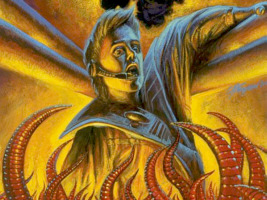
 Blood and Fire cover
Blood and Fire cover